Top News

October 31, 2012 Ryukyu Shimpo
On October 30, the U.S. Marines in Okinawa conducted night flying training for two MV-22s from Futenma Air Station. The two Osprey vertical take-off and landing transport aircraft flew back to the base after 10:00pm. The noise-prevention agreement reached between the U.S. and Japanese governments stipulates that the Marines are not to fly the aircraft after 10:00pm. With this training exercise, the U.S. military have effectively torn up the agreement just about one month since the deployment of the Opsrey to Futenma, which fuels the anger of the Okinawan people.
The Marines plan to increase flight training for the Osprey at night from 10:00pm to 7:00am, and are expected to operate the aircraft during those hours from now on.
The two MV-22s took off Futenma Air Station at 7:17pm and then 7:20pm. The aircraft were confirmed to have repeatedly circled over Camp Schwab in the Kushi district of Nago for at least 20 minutes from around 8:20pm before flying to the Iejima Auxiliary Air Base. They then repeatedly practiced stake-off and landings, and flew in a circle above the landing area until around 10:00pm. Osprey night flying training has also been confirmed as having occurred in the Northern Training Area. One MV-22 landed back at Futenma Air Station at 10:17pm, and the other at 10:24pm.
The agreement stipulates that the Marines not to conduct any operations of the Osprey during the period from 10:00pm to 6:00am unless the U.S. government specifically sees them as being necessary. The agreement reached between the U.S. and Japanese governments regarding the safety of deploying the Osprey requires the Marines to observe the noise-prevention agreement that has been put in place.
On October 30, the Marines conducted flight training for six MV-22s from Futenma Air Station. While the Marines conducted a water-discharge exercise, Osprey flew over Prefectural Road 71, with buckets suspended below them.
The Marines have been increasing night flying training since October 29. According to the Okinawa Prefectural Government and the Ginowan Municipal Government, at 7:59pm on October 29, the noise generated by the flight training reached 89.7db at Ueojana Community Hall, which is located next to the southern end of the runaway at Futenma Air Station.
(English translation by T&CT, Mark Ealey)
Go to Japanese
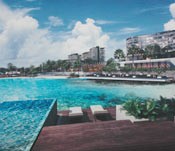
October 23, 2012 Ryukyu Shimpo
On October 22, at the Kin Municipal Office, Mayor Tsuyoshi Gibu and Tan Chee Sing, the chief executive officer (CEO) of Dijaya Land Development, a Malaysian major property development company, announced that they have signed a contract to build hotels in the former U.S. Marine Ginbaru Training Area, which was returned to Kin Town in July 2011.
Dijaya plans to construct a five-star internationally branded hotel with about 200 rooms, a spa resort hotel with about 180 rooms, and 200 to 400 rooms in houses and condominiums. They will also develop a giant commercial facility that handles local farm and marine products, has wedding halls and facilities for marine sports. The plan is linked with a medical tourism concept in which Kin Town will establish medical facilities in the same area.

On October 22, at the Kin Municipal Office, Mayor Gibu (left) and CEO Tan signed a contract to build a hotel complex.
The development will start in 2013 and occur over a 15-year period. The land covers about 16 hectares and will be leased for a 100-year term. Dijaya will invest 60 billion yen into the project, which is estimated to create 800 jobs.
Mayor Gibu said that this project will help to wean their local economy off dependence on U.S. military bases and will promote self-sustaining development. CEO Tan said, “The beautiful sea moved me and I felt sure that this project will succeed. I want to do something for the local community through this development.”
Kin Municipal Office and Dijaya exchanged memorandums of understanding in May and signed a letter of intent on October 18.
(English translation by T&CT, Lima Tokumori and Mark Ealey)
Go to Japanese
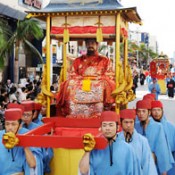
October 29, 2012 Ryukyu Shimpo
On October 28, the third day of the Shurijo Castle Festival commemorating the 20th anniversary of the opening of Shurijo Castle Park, a Ryukyu Dynasty-style Royal procession was held in Kokusai Street in Naha. The festival was organized by the event’s executive committee, with assistance from the Shuri Promotion Association, the Naha Junior Chamber and the Ryukyu Shimpo Newspaper.
About one thousand people participated in the procession, which consisted of three main parts, one for the king and queen of the Ryukyu Kingdom, one for Chinese envoys and the other for parties of traditional entertainers. The festival commenced with the procession of the king and queen of the Ryukyu Kingdom. It entertained the many spectators who gathered along the road with bustling performances of traditional hatagashira or flag pole performances, and groups of people dancing the kachashi.
Naoki Tanaka and Rumi Tsukahara, who visited Okinawa from Honshu to see the festival, said, “The queen was beautiful. The climax of the festival was the eisa dance. We had a great time.”
(English translation by T&CT, Mark Ealey)
Go to Japanese

Go To Video
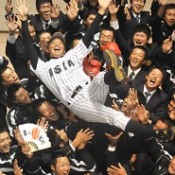
October 26, 2012 Ryukyu Shimpo
On October 25, in the Nippon Professional Baseball (NPB) draft, the Fukuoka Softbank Hawks have won the right to negotiate with Nao Higashihama, who is now a player at Asia University but is originally from Okinawa Shogaku High School. Higashihama is a right-handed pitcher currently in the spotlight because of his shutout record and for achieving the most strikeouts in the Toto League. Three teams chose him in the first-round draft, and by drawing lots Softbank won the right to negotiate with him.
Okinawan players selected this year’s draft of the NPB included left-handed pitcher Hiroya Kawamitsu of Kyushu Kyoritsu University, who is originally from Miyako Sogo Jitsugyo High School, and was picked in the second-round draft by the Chiba Lotte Marines, outfielder Hirohito Shimai of the Golden Laax Kumamoto, and a former player of Big Kaihatsu, from Nishihara Senior High School, who was picked in the fifth round by the Tohoku Rakuten Golden Eagles and right-handed pitcher Shogo Yagi of JX-ENEOS, from Kokushikan University and Okinawa Chubu Commercial High School, who was picked in the sixth-round by the Hokkaido Nippon-Ham Fighters.
Three teams, including Softbank, the Yokohama DeNA BayStars and the Saitama Seibu Lions, have indicated their interest in Higashihama in the first-round draft. Sadaharu Oh, the president of the Softbank team and himself a famous former baseball player, drew the lucky ticket to secure the right to negotiate with the number one ranked candidate. At the news conference held at Asia University,
Higashihama commented, “Softbank is a good team with excellent pitchers. I am glad to be nominated by the team such as Softbank. As a professional baseball player, I want to do my best to meet the expectations of the people of Okinawa.”
In the first-round draft, four teams have picked Shintaro Fujinami, a talented pitcher from the Osaka Toin High School team that won the spring and summer Koshien titles this year and Hanshin Tigers drew the ticket for the right to negotiate with him. The Nippon-Ham Fighters was the only team to specify Shohei Otani, a pitcher from Hanamaki Higashi High School.
(English translation by T&CT, Mark Ealey)
Go to Japanese
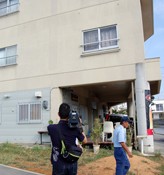
November 3, 2012 Ryukyu Shimpo
At around 1:00am on November 2, the Kadena Police Station received an emergency call from a bar in the Furugen district of Yomitan to the effect that a member of the U.S. military was drunk and causing a disturbance. The man was found by the police after he had collapsed near the bar, from there was taken to the U.S. Naval Hospital in Chatan, where it was established that he has broken ribs and a punctured lung. Just before the police arrived at the scene, a man who appeared to be a member of the U.S. military entered an apartment on the third floor of the same building as the bar and hit a 13 year-old junior high school student who was asleep. When they can get to see the injured man after he recovers, the police plan to ascertain whether he actually did commit acts of trespass, assault and damage to property.
The U.S. military forces in Japan have placed a nighttime curfew on all their military personnel in Japan from 11:00pm to 5:00am following the alleged rape of a woman in the central region of the main island of Okinawa on October 16 by two U.S. military personnel.
With regard to the investigation of the man, if he does turn out to be a member of the U.S. military, Chief Cabinet Secretary Osamu Fujimura stated, “We do not think it will be necessary to formally request the man to be handed over before charges are laid.” An increasing number of Okinawan people have voiced their strong displeasure with this statement made before the Okinawan Prefectural Government completes its investigation.
According to a police representative, the junior high school student suffered a bruise on his left cheek, which take a week to heal. The man’s identification card, which he dropped at the scene, identifies him as a 24 year-old member of the U.S. military stationed at Kadena Air Base. After assaulting the boy, and damaging a television in the room, the man is said to have had a fall when trying to get out through a window. An elementary school age boy who was also in the room at the time was not injured.
The mother of the boy hurt in the incident was incensed, saying, “I am shaking with anger to hear that the police took the man to the naval hospital, and so he was not able to be taken into custody. It is outrageous that a man would assault a young boy like this.”
Go to Japanese

October 29, 2012 Ryukyu Shimpo
The second Koza A-lunch Competition was held at the Koza Sports Park in Okinawa City over the two days of October 27 and 28.
According to the organizer, about 20000 people visited the event.
A total of 21 restaurants from throughout the prefecture competed In Okinawa City, which is the birthplace of the A-lunch concept, in which various European foods are served on a plate.
Voting saw the Japanese tavern Izakaya Primo, which is located in the Kinjo area of Naha, win the highest award, followed by the Bistro Maru of Okinawa City,
which served an Italian A-lunch. TiTiCaCa of Okinawa City came third with a Peruvian A-lunch. Primo served a Pirate A-lunch, featuring a hamburger with a chicken wing inside, trying to conjure up the impression of pirates, who are more than a little rough in the way they eat. The Olive Batake, also from Okinawa City, won the Mayor’s Award, Tsudoi Dining Kuina won the Head of the City Assembly Award and Umizoku Kobo won the Head of the Municipal Education Board Award.

On October 28, at the Koza Sports Park in Okinawa City, the award winning contestants, and those who earned an honorable mention, were delighted with the results.
(English translation by T&CT, Mark Ealey)
Go to Japanese
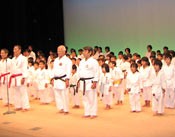
October 23, 2012 Ryukyu Shimpo
On October 20, the Naha Karate Association (NKA) and Naha Municipal Government held a symposium entitled “Naha, Home of Karate and Traditional Martial Arts 2012” at Palette Civic Theater in Naha. They recommended that karate be expanded globally and suggested Naha as the venue for the Karate-do Hall that the Okinawa Prefectural Government is planning to establish.
Seitoku Ishikawa, the head of the Okinawa Shorin-ryu Karate-Do Association is probably the only person who understands the traditions of karate in pre-war Okinawa. He stated in his speech that in the past karate was concealed from others, and that a recommendation from a person with some standing in society was required in order to be accepted to learn karate. In order to test their determination people asking to be mentored were refused every day for a week. “The most important thing in karate is character development. We have to be conscious of our role as leaders in society,” said Ishikawa.
In the panel discussion, representatives of Goju-ryu, Shorin-ryu and Matsubayashi-ryu talked about the origins of karate: the Naha style, the Shuri style and the Tomari style. They explained the features unique to each style. The Shuri style used a makiwara, a post wrapped in straw for training, and its exponents tried to focus all their strength in split seconds of action. The Naha style is more orthodox and respects good manners. The Tomari style aims to develop a student’s character and trains them with that in mind.
Head of the Secretariat of the Okinawa Traditional Karate Liaison Bureau, Miguel Da Luz, explained that there are 60 million karate fans around the world and that karate has been gaining popularity quite independent of the Okinawan influence. He said, “If people learn the history of karate, they will want to come to Okinawa. Exponents of karate will come to Okinawa hoping to understand its spirit and to foster karate camaraderie.” He insisted that, in order to meet the expectations of people’s passion for karate, it needs to be advertised even more and taken to every corner of the globe.
Towards the end of the symposium, all in unison, some 150 children between kindergarten and junior high school age who go to NKA practice halls said, “We are proud of Naha as the home of karate and traditional martial arts. We will practice hard and be polite. We will expand our exchange with our friends around the world.”
(English translation by T&CT, Lima Tokumori and Mark Ealey)
Go to Japanese
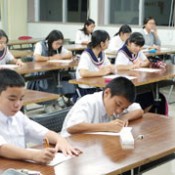
October 26, 2012, Ryukyu Shimpo
On October 22, at the Kitanakagusuku Central Community Center, the opening ceremony for the distance e-learning English as a Second Language program was held. Pupils will be taking an intensive English language program taught by teachers of the Washington State University (WSU). This program came to fruition this April through a joint agreement between the WSU, Kitanakagusuku and the non-profit organization the Ryukyu America Historical Research Society. It is the first time for the university to enter into such an agreement on an English language program with a municipal office in Japan.
The aim of the program is to help cultivate human resources capable of contributing to Okinawa’s future. The official starting date of the program is in November and a total of about 20 pupils from the village will participate. It also helps participants acquire the necessary language skill for future possible attendance at American universities as well as for work opportunities.
According to Shizuo Kishaba, the chairman of the society which initiated the program, American universities require Okinawan students to undertake a program of language study before they attend universities due to their insufficient English language skills. “If we think about the economic situation for Okinawan families, this extra requirement is quite a burden for them.” Having sufficient language skills to start with will allow participants to concentrate more on their university studies as well as on setting up a stable living environment overseas.
Kitanakagusuku mayor, Kunio Arakaki, commented, “Human resources are a precious treasure that we have in our village. We hope that they broaden their horizons and that their efforts will contribute to the village’s development.” One of the participants, Ishiru Tamaki, “I began to enjoy learning English after I’d been in the summer program for study in the United States. I like mathematics too, so maybe I can study it at an American university.”
(English translation by T&CT, Kyoko Tadaoka and Mark Ealey)
Go to Japanese
October 22, 2012 Ryukyu Shimpo
On October 22, the Okinawa Prefectural Assembly held a special meeting in which it unanimously passed a protest resolution and accepted a written statement of opinion regarding the case in which two U.S. navy sailors have been charged with the rape of an Okinawan woman. In addition to a radical revision of the U.S.-Japan Status of Forces Agreement and a full apology and compensation to victims, for the first time, the assembly requested that the governments of the United States and Japan move to return all U.S. bases in Okinawa, without identifying the name of any individual facility.
After their meeting, in order to lodge their protest, members of the Special Committee on the U.S. Military Base Relations of the Assembly visited the Okinawa Defense Bureau, the Okinawa Liaison Office of the Ministry of Foreign Affairs and the U.S. Consulate General in Okinawa.
On October 23, in Tokyo, representatives from each political faction of the Prefectural Assembly protested to the Japanese government and U.S. military officials. Their protest resolution and statement of written opinion will go to the Prime Minister, Foreign Minister, and Defense Minister, U.S. Ambassador to Japan, Commander of U.S. forces in Japan and the Commander of U.S. Naval Forces Japan.
In the protest resolution the Assembly criticized the U.S. military for measures it has taken, pointing out that “U.S. forces’ efforts to prevent recurrences of incidents and the education of military personnel are no longer effective.”
Considering that the rape occurred just when there is a growing upswell of opinion against the Osprey deployment among the Okinawa people, the Assembly stated that the situation “far exceeded the limit of residents’ patience, and also call for a full withdrawal of the bases.” In the written statement of opinion and the protest resolution, the Assembly has requested the reduction of U.S. bases in Okinawa and the return of land used by the U.S. military in the prefecture.
(English translation by T&CT, Mark Ealey)
Go to Japanese
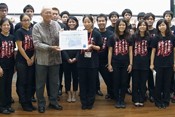
October 21, 2012, Ryukyu Shimpo
The second World Youth Uchinanchu Festival will be held in Los Angeles at the end of next June. This festival that brings together Uchinanchu youth from all around the globe is organized by the World Youth Uchinanchu Association (WYUA), and the announcement about next year’s event was made at the debrief from the first festival, which was held in Brazil this July. The date for next year’s festival will be confirmed in November, but it is expected to be between July 21 and 31. A total of about 150 people from nine countries in South and North America, Europe, as well as Japan and Okinawa are due to participate.
At the briefing, a ceremony was held to make a donation to the WYUA Fund, which was established through the Mirai Fund Okinawa Inc. Foundation to provide financial support for the festival. One of the initiators of the fund, Eishin Chinen, the Chief Councilor and Deputy Director General from the Okinawa Convention and Visitors Bureau, handed over donations totally 120800 yen collected between June and August to Minami Tamamoto, who is the director of the Okinawa head office of the WYUA.
At the briefing, there were reports on some of the activities from the last festival in Brazil, and afterwards Tamamoto commented, “We would like to create some networks at the next festival.”
WYUA is asking the public for contributions to the fund. Donations can be made in cash or by credit card. Please contact the Mirai Fund Okinawa on 098 884 1123 for further details.
(English translation by T&CT, Kyoko Tadaoka and Mark Ealey)
Go to Japanese
October 22, 2012 Masanao Chinen of the Ryukyu Shimpo
On October 21, the Naha Municipal Office announced that it will incorporate greetings in Uchinaguchi into this year’s employment test interviews. This is a part of the “Haisai, Haitai Campaign” in which staff members are encouraged to greet people in Uchinaguchi at the Municipal Office. By adopting Uchinaguchi in the employment test the Municipal Office aims to encourage young people to use the Okinawan language.
It is rare for a municipal office in Japan to adopt a local language in its employment interviews, and this is the first such attempt in Okinawa Prefecture. Mayor Takeshi Onaga instructed officials to consider the adoption of Uchinaguchi in the employment test based on opinion that surfaced when the City entered into dialogue with the City Culture Association.
The Municipal Office will send a letter to the candidates sitting the employment interview asking them to prepare a self-introduction in Uchinaguchi to deliver at their interview. For those who are not familiar with Uchinaguchi, the City will provide some examples, such as “Haisai gusuyo, chuuganabira? (Hello, how are you today?), and Nife debiru (Thank you).”
Meanwhile, to ensure fairness in the examination, intonation and fluency in Uchinaguchi will not be assessed. An official from the Municipal Office said, “It is acceptable if they indicate a willingness to use Uchinaguchi once they are hired.”
Professor Masahide Ishihara of the University of Ryukyus (Language Policy) said, “It will be a good chance for the people taking the test to learn Uchinaguchi. Implementation of this approach in the Naha Municipal Office may encourage other local governments and private companies to do the same. I hope that they engage in training projects that encourage the use of Uchinaguchi after they take up employment.”
A total of 1817 people applied to sit the 2012 employment examination for the Naha Municipal Office. The written examination was conducted on October 14. The second examination, which includes an interview, will be held on November 17 and 18 for administrative positions and on November 24 and 25 for preschool teaching positions.
(English translation by T&CT, Megumi Chibana and Mark Ealey)
Go to Japanese












 Webcam(Kokusai Street)
Webcam(Kokusai Street)


